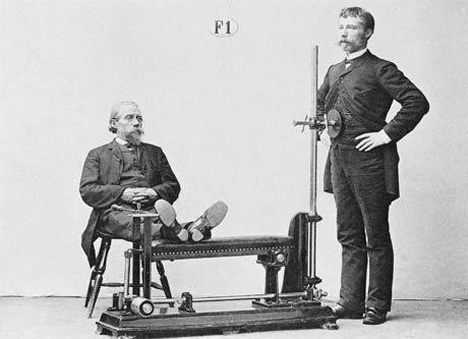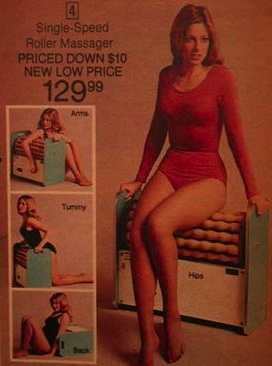
Once humans did not worry much about exercise. When we had to kill, gather, grow, or herd our own food, working out happened naturally. As soon as we figured out how to avoid those laborious chores, we did. Not long after, we had to invent new ways of staying in shape therefore we exercise.
“Kellogg had some unorthodox ideas about health.”Exercising is an energy-draining and time-consuming process, so the minute we started making machines to do our labor, we also made machines to do our workouts for us. In fact, if it weren’t for Victorian ingenuity, such terrible places as the sweat-drenched neon-lit 24-hour gyms would not exist.
While some of their inventions evolved into modern gym equipment, many were as physically useless as they were absurd-looking. Despite what you might think, such pointless exercise contraptions are not just things of the past. In fact, most of them have modern counterparts that are sold on TV informercials today. Here is a look at effort-free exercise gizmos through the ages.
Victorian Era

Swedish physician Gustav Zander is the man to blame for “the gym.” His Zander Institute, established in the late 1800s, featured 27 machines he designed himself to help his wealthy clientele improve fitness. Some of these were the forebears to StairMasters and modern weight machines. Others, like this ab-rolling machine (above) or horse-riding simulator (below), had little more physical benefit than a good massage.

In late 1800s America, Dr. John Harvey Kellogg was the chief physician at the famous Battle Creek Sanitarium in Michigan, a high-end health resort that inspired the 1994 movie, “The Road to Wellville.” Kellogg, who invented corn flakes and bran flakes with his brother, Will Keith Kellogg, the founder of the Kellogg’s cereal company, had some unorthodox ideas about health.


On the one hand, Dr. Kellogg introduced several revolutionary ideas that are widely accepted in medicine today: that diet and exercise are vital to good health; that intestinal health, supported by consuming fiber and probiotic yogurt, is essential to well-being; that sex can pass nasty diseases; that smoking can cause lung cancer; and that coffee can do serious damage. On the other, he advocated complete celibacy, female genital mutilation, electroshock therapy, eugenics, racial segregation, and even immersion in freezing radium-laced water as a therapy. Like Zander, he advocated massage machines as exercise, like this rolling device (above), which was used well into the 1970s, as a page from a 1977 JCPenney catalog shows.

Outside of crunchy cereal goodness, perhaps Kelloggs’ mostly lasting legacy is the concept of vibrating your way to fitness. Thanks to the marvelous development of harnessed electricity, he engineered a wooden vibrating chair (above) around 1900, which he claimed could clear out the intestines, dissolve backaches and headaches, and improve muscle tone. Apparently, this chair was so uncomfortable—painful, even—that no one wanted to use it. So much for sitting your way to slender! For the moment …

In 19th century, another scientific phenomenon that seemed just as magical as electricity was magnetism. This magnetized or “electric” corset, seen in an advertisement above, offered you not only a teeny tiny wasp waist but also a cure for indigestion, rheumatism, paralysis, and “general debility.”
The 1920s and 1930s
Corsets fell out of fashion in the Roaring Twenties, but inventors found other ways to incorporate bondage into passive fitness. This 1921 Molby Revolving Hammock (below) promised to stretch your muscles as it straightened your spine and calmed your nerves. For the ladies, there was the promise of an hourglass figure, with a smaller waist and “fuller chest.”
Naturally, people still loved the idea of sitting and letting the chair do the work. Zander’s horse-simulation concept made a comeback with this 1931 Mechanical Wondercycle Exercisulator (below), a “hobbyhorse for adults.” Text in “Popular Science” magazine asserted the trotting motion could work the muscles in the legs, back, stomach, and neck.

This 1936 mechanized Magic Chair (below) offered multiple ways for a lady to slim down and become more attractive by simply sitting. She could slenderize her waist by letting it twist her side-to-side, work away bulk from her ankles, and, finally, massage her chin to a small shape while stretching her spine and correcting her posture.

Even though we think of vibrating belt machines as products of the ’50s, they were first introduced in 1928, by none other than Kellogg’s health facility, as the Battle Creek Health Builder (below, right). Women wanting to attain a svelte flapper figure hoped to vibrate their fat away.


1950s, ’60s, and ’70s
Vibrating belt machines became even more popular when soldiers came home from World War II, as their wives and girlfriends put away their sturdy shoes and work dungarees and tried to look more like the bombshells of pinup magazines that kept the men company those lonely nights abroad. The style of the day (stiletto heels, Christian Dior dresses) required a smaller waist and bigger bust line. What about those ladies stuck with stubborn love handles? They tried to vibrate their way to a tiny waist, naturally. The innate silliness of these devices made for comedy gold—they were spoofed everywhere from cartoons to “I Love Lucy” to “Pee-Wee’s Playhouse.” Still, they remained popular well into the 1970s.

But when vibration wasn’t enough, women then turned to the next logical step: electric shock. The Relax-a-Cizor (below), first introduced in 1949, promised to zap the fat off. More than 400,000 of these babies were sold before they were taken off the market in 1970, due to some unpleasant side effects—apparently, the high voltage could cause abnormal heart rhythms, miscarriages, and aggravate hernias, ulcers, and epilepsy. This device made an appearance in the true-to-the-’60s show “Mad Men,” in which Peggy finds a much more interesting use for it than fat-burning.

Probably one of the most fun exercise-gadget fads of the era was inspired by Chubby Checkers’ 1960 dance craze “The Twist.” Manufacturers put together the simplest machines imaginable, made of rotating pieces of pressed particle board, and gave them fun brand names like Slim-Twist Exerciser, Twist Board, and Gyro Slim ‘n’ Trim Exerciser (below). Show & Tell regular electobacco recently posted one from his collection. You could put on a rock’n'roll 45 and twist your waist away with a li’l less effort than simply doing the dance.


No comments:
Post a Comment